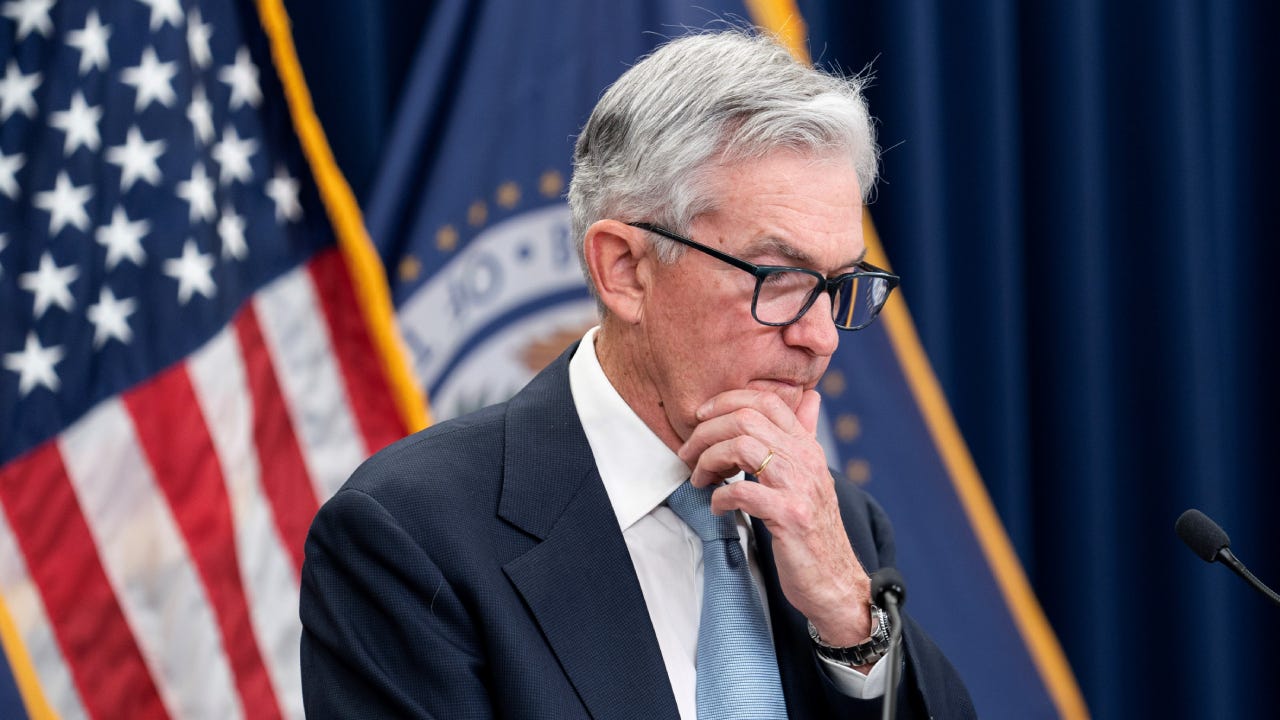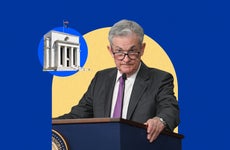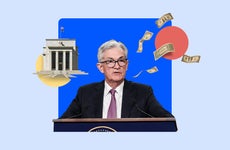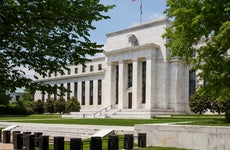Survey: Fed seen lifting rates one more time before cutting in 2024

The Bankrate promise
At Bankrate we strive to help you make smarter financial decisions. While we adhere to strict , this post may contain references to products from our partners. Here's an explanation for .
The Federal Reserve’s aggressive and forceful measures to cool the most overheated economy in four decades may soon be coming to an end, according to the nation’s top economists.
More than half (or 53 percent) of experts polled for Bankrate’s First-Quarter Economic Indicator poll say the Fed’s key benchmark interest rate will peak in a target range of 5-5.25 percent, suggesting officials will likely only hike rates one more time.
But that doesn’t mean rate cuts are around the corner. More than four-fifths of economists (or 82 percent) say officials likely won’t begin cutting borrowing costs until 2024, even as the recent failure of the nation’s 16th largest bank risks worsening financial stability.
Both estimates are largely in line with fresh projections from officials in March. The Fed penciled in a 5-5.25 percent peak interest rate for 2023, after which officials see rates falling to 4.25-4.5 percent by the end of 2024.
The survey findings are notable because they suggest economists are still seeing eye-to-eye with policymakers on the U.S. central bank at a time when investors are starting to divulge. Market participants expect the Fed will lift rates one more time before turning around and reducing borrowing costs as soon as July, according to CME Group’s FedWatch.
Where borrowing costs end up has massive implications for consumers. Higher rates translate to more expensive mortgages, auto loans and credit cards, and they risk harming hiring and the economy. On the other hand, they make it an even more lucrative time to be a saver — who’ve already been seeing the highest savings yields in more than a decade thanks to the rapid run up in interest rates.
For individuals and households, this argues even more loudly for making emergency savings a high priority. Fortunately, returns on savings including certificates of deposit are the highest in 15 years.— Mark Hamrick, senior economic analyst at Bankrate
Key takeaways:
- Fed seen lifting rates two more times before cutting in 2024
- Inflation to keep decelerating this year as economy slows from high interest rates
- Odds of a recession in 2023 hover at 64% amid bank failures and higher rates
- Economists see jump in unemployment and major job losses over next 12 months
Fed’s dilemma: How hot is inflation – really?
Nearly one-fifth (or 18 percent) of economists say the Fed will have to hike interest rates two more times — the second largest majority among respondents. Meanwhile, nearly an eighth (or 12 percent) say the Fed has three more rate hikes. Just 6 percent say the Fed is already done raising interest rates.
“The Fed has a hammer, so everything must be treated as a nail,” says Bill Dunkelberg, chief economist at the National Federation of Independent Businesses.
The Fed’s rate path depends on what happens with inflation. Consumer prices have likely already peaked, with inflation falling to 6 percent in February after soaring as high as 9.1 percent last June. Yet, price pressures to start the year haven’t been cooling as quickly as they were just three months ago.
Just 18 percent of economists said the Fed could cut rates this year, down sharply from 38 percent in the fourth-quarter poll.
The economists who do project rate cuts point to how much data can lag behind what’s happening within the U.S. economy. Rent prices, for example, have mounted a continuous surge since early 2021, with those costs most recently rising 8.8 percent in February from a year ago. Shelter accounted for more than 70 percent of February’s increase, according to the report, even as real-time measures show new lease prices are falling. The reason for the delay is by design: Leases roll over only once a year, meaning they aren’t immediately reflected in the index.
Recent bank failures could also dampen consumer spending and business investment, as financial institutions offer fewer loans to retain enough money on hand to cover their customers’ needs.
All of those factors could cause prices to quickly decelerate, suggesting the Fed doesn’t have to be so aggressive by keeping rates at their decade-plus high.
Even so, inflation is currently coming from so-called “stickier” components, meaning prices that change relatively slowly, according to an analysis from the Atlanta Fed. The Fed’s preferred way of measuring inflation — based on the Department of Commerce’s personal consumption expenditures (PCE) index, which already tracks lower than the Labor Department’s consumer price index (CPI) — is seen as moderating to 3.3 percent by the end of 2023.
Fed officials have reiterated they’re more worried about pulling back too soon — leading to elevated inflation for longer — than they are about overshooting on interest rates and raising borrowing costs too much.
“It’s unlikely that inflation will reach the Fed’s 2 percent target in 2023,” says Odeta Kushi, deputy chief economist at First American Financial Corp. “As such — barring any major recession or unforeseen economic shock — the Fed is unlikely to cut rates until at least 2024.”
Hear from the experts
The Fed is unlikely to cut rates until 2024 or later due to the need to assess the lagged impact of the prior rate increases. The tradeoffs between stabilizing and reducing inflation versus mitigating the decline in economic growth and job losses will become more evident as the markets digest the rate increases.
— Nayantara Hensel, chief economist, Seaborne Defense
2023 [for rate cuts] is too soon. Even if the economy got very weak quickly, inflation would be too high to enable a cut. Markets have been too eager for the Fed to not hike, to stop hiking, to cut rates and have been repeatedly wrong. Maybe these have been bets on banking sector problems welling up and stopping the Fed, or maybe it was just ‘something in the water.’ I view market prices as peculiar.
— Robert Brusca, chief economist at Fact And Opinion Economics
We continue to assume that the Fed tightens by 25 basis points at both the May and June FOMC meetings, on the assumption that the worst of the banking sector crisis is behind us, and as the various year-over-year inflation gauges remain well above 2 percent.
— Mike Englund, chief economist at Action Economics
-
The First-Quarter 2022 Bankrate Economic Indicator Survey of economists was conducted March 23-30. Survey requests were emailed to economists nationwide, and responses were submitted voluntarily online. Responding were: Odeta Kushi, deputy chief economist, First American Financial Corporation; Yelena Maleyev, economist, KPMG; Scott Anderson, chief economist, Bank of the West; Nayantara Hensel, Ph.D., chief economist, Seaborne Defense; Joel L. Naroff, Naroff Economics; Mike Fratantoni, chief economist, Mortgage Bankers Association; Robert Frick, corporate economist, Navy Federal Credit Union; John E. Silvia, CEO and founder, Dynamic Economic Strategy; Dante DeAntonio, director of economic research, Moody’s Analytics; Bernard Markstein, president and chief economist, Markstein Advisors; Lawrence Yun, chief economist, National Association of Realtors; Robert Brusca, chief economist, Fact and Opinion Economics; Bill Dunkelberg, chief economist, NFIB; Gregory Daco, chief economist, EY; Lindsey Piegza, Ph.D., chief economist, Stifel; Eugenio J. Alemán, Ph.D., chief economist, Raymond James Financial; and Mike Englund, chief economist, Action Economics.
Related Articles

Will stubborn inflation force the Fed to raise interest rates again?

Survey: Fed won’t begin cutting interest rates until 2024 as officials keep tackling inflation

Survey: Expect the Fed to cut rates at least two more times over the next year

Survey: Economists split on whether Fed will cut rates in first or second half of 2024